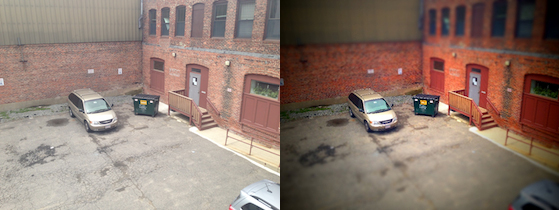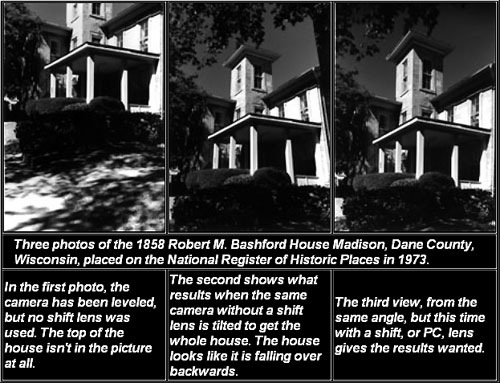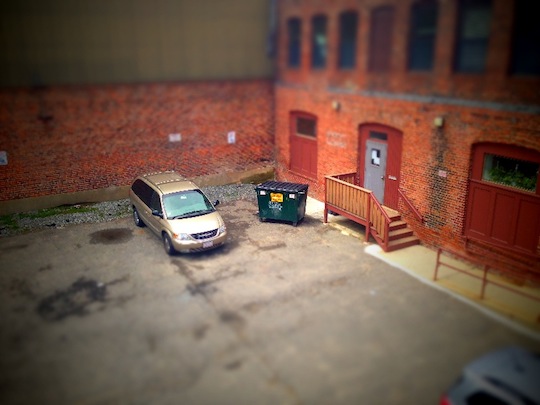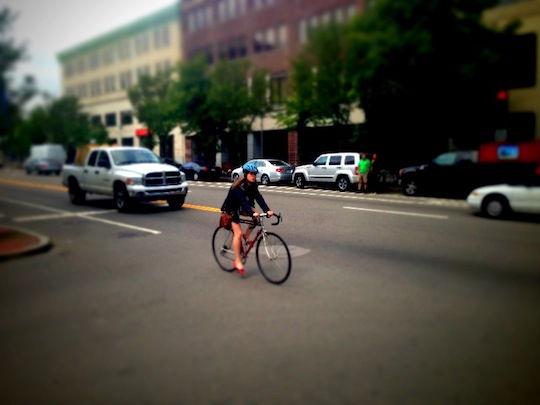Reviewed.com: A guide to tilt-shift photography
Tilt-shift photography: You may not know the term, but you definitely know the style. The most common application of tilt-shift is selective focus. When it's done well, this creates a “miniature” effect in photos, making scenes look like dioramas and people like figurines. Here's an example.
 Left: Basic iPhone image; Right: Same image through TiltShift Generator app
Left: Basic iPhone image; Right: Same image through TiltShift Generator app
There are also practical, professional applications of tilt-shift photography. For example, the ability to shift the lens plane allows photos to better emulate the perspective of the human eye.
While it's been in use for a long time, tilt-shift photography has become especially popular in recent years, thanks in large part to digital photography and advances in image editing software. Want to know more about the hypnotic power of tilt-shifted images? Here are the basics.
1. It's Simpler Than You Think
Tilt-shift is easier to understand if you explore the history of cameras[1]. Early devices required flexible bellows—those accordion-like contraptions you find on old cameras. This design allowed photographers to “shift” the lens plane while keeping it parallel to the film, as well as “tilt” the lens back and forth, like a mirror on a swivel.
The ability to shift the lens plane allows photos to better emulate the perspective of the human eye.
This is basically what modern tilt-shift lenses do, too. Without getting into too much detail, “shifting” the lens relative to the sensor can correct for the convergence of parallel lines—like you see when you try to take a picture of a building while you're standing next to it. “Tilting” the lens has a number of applications. One of them is the miniature effect mentioned above; another is to capture super-sharp landscapes at wide apertures.Together, tilting and shifting techniques give filmmakers and photographers a broader palatte of aesthetic possibilities[2].
2. It’s Getting Really Popular
Tilt-shift has become popular[3] for a number of reasons, but its use in a slew of recent Hollywood films and viral videos did perhaps more than anything to raise its stature. Sam O'Hare’s viral short The Sandpit depicts a single day in New York City—all in tilt-shift—and has amassed nearly 1 million views.
The 2010 film The Social Network employed tilt-shift in the rowing scene, shot at the Henley Royal Regatta[4] in England. Director David Fincher told Slash Film[5] that the decision was based partly on the need to obscure members of the crowd: “I decided it might be more ‘subjective’ if the world around the races fell away in focus, leaving the rowers to move into and out of planes of focus to accentuate their piston-like effort.”
While Trent Reznor’s backing score may have been the cherry on top, this was not the first use of tilt-shift in a major commercial production. Extremely Loud & Incredibly Close, Minority Report, the TV show Sherlock, and even the music video for Thom Yorke’s “Harrowdown Hill[6],” are members of the tilt-shift club.
3. Architectural Photographers Use It
As mentioned, the shift function of a tilt-shift lens can correct for the skewed perceptive that happens when you photograph a tall building from the ground. This gives it an obvious appeal for shooting architecture.
In normal photography, if the subject is parallel to the sensor—a head-on shot of a bottle, for instance—then the parallel lines in the image will remain parallel. However, when the subject is at an angle to the sensor—like the view of a church steeple from the street—lines that are actually parallel will appear to converge. This can look unnatural, as if the steeple is falling backwards. Shifting the lens can help to correct this distortion.
 Credit: Wikipedia Commons user Motorrad-67
Credit: Wikipedia Commons user Motorrad-67
4. There’s An App For That
Everything we've covered so far has had to do with real tilt-shift lenses, which are incredibly expensive. But you don't need to spend $2,000 to experiment with the tilt-shift look. There are plenty of mobile apps that simulate the miniature (or selective-focus) effect. They can’t give you the professional look of an actual tilt-shift lens on a DSLR, but they are much cheaper.
I purchased a $0.99 iPhone app called TiltShift Generator and took a few pictures around our offices in Cambridge, Mass. It makes it easy to turn regular snapshots into photos that look like they were shot with a tilt-shift lens. No, it isn't the real thing, but for a buck, it's a lot of fun to play around with.


5. You Can Do It In Photoshop
You don't even need an app to turn your photos into tilt-shift simulations—it's easy to fake the effect in Photoshop. As with most digital-enhancement techniques, there are a few ways to pull it off. To make your job easier, first pick a photo with a clear subject and some peripheral objects in the background to give it perspective. It also helps to use an image taken from a high vantage point.
Digital Camera World[7] has a very thorough rundown of how you can achieve the miniature effect in Photoshop, but remember that your main goal is to maintain focus on your subject while blurring everything else. Boosting the saturation also helps achieve the "miniature" look. I was able to do this in Photoshop Elements with an image from my iPhone 5. Not bad, eh?
 iPhone image with a tilt-shift effect simulated in Photoshop
iPhone image with a tilt-shift effect simulated in Photoshop
 iPhone image, pre-Photoshop
iPhone image, pre-Photoshop
References
- ^ explore the history of cameras (www.techradar.com)
- ^ aesthetic possibilities (mentalfloss.com)
- ^ popular (articles.latimes.com)
- ^ Henley Royal Regatta (en.wikipedia.org)
- ^ told Slash Film (www.slashfilm.com)
- ^ Harrowdown Hill (www.youtube.com)
- ^ Digital Camera World (www.digitalcameraworld.com)









